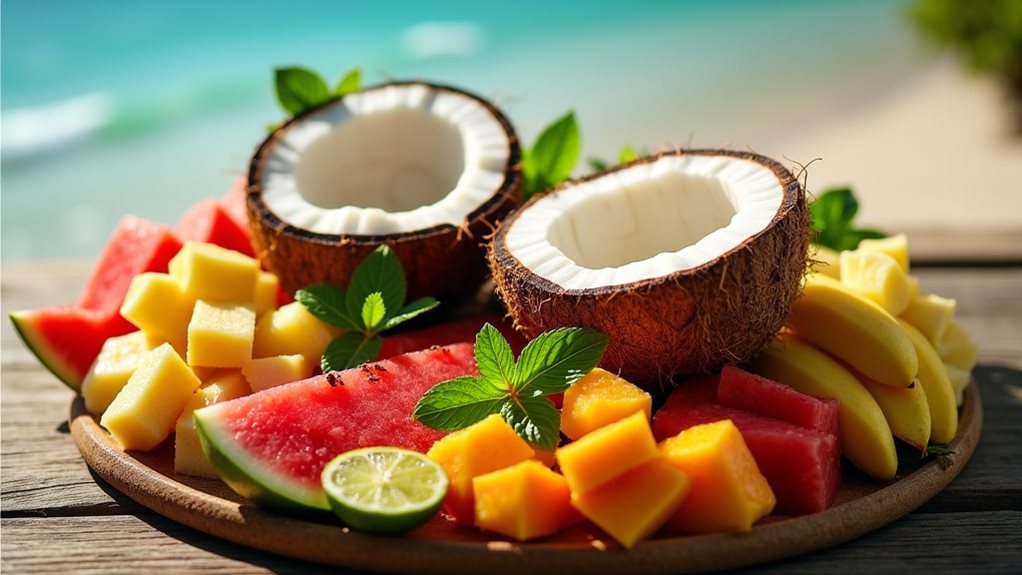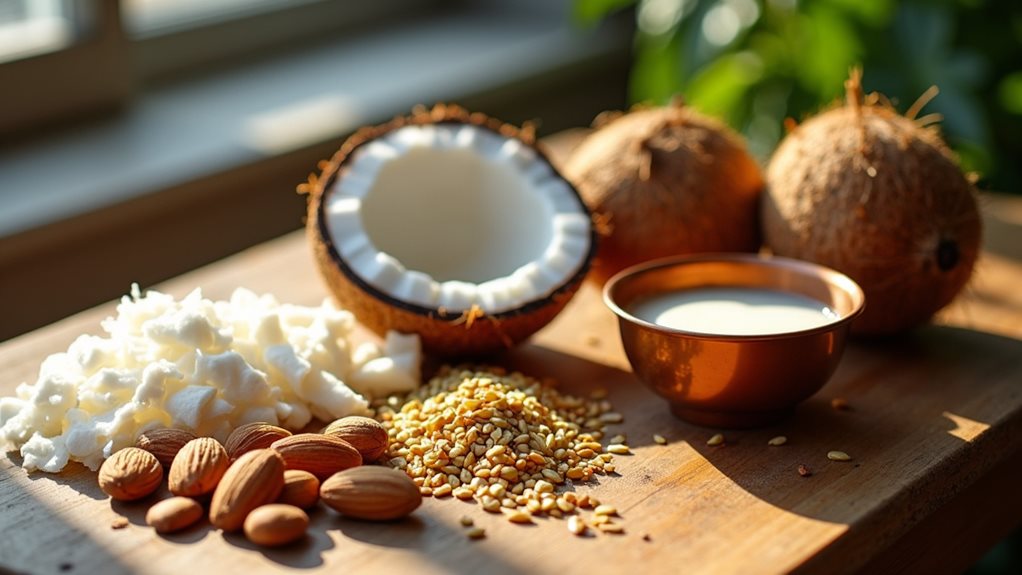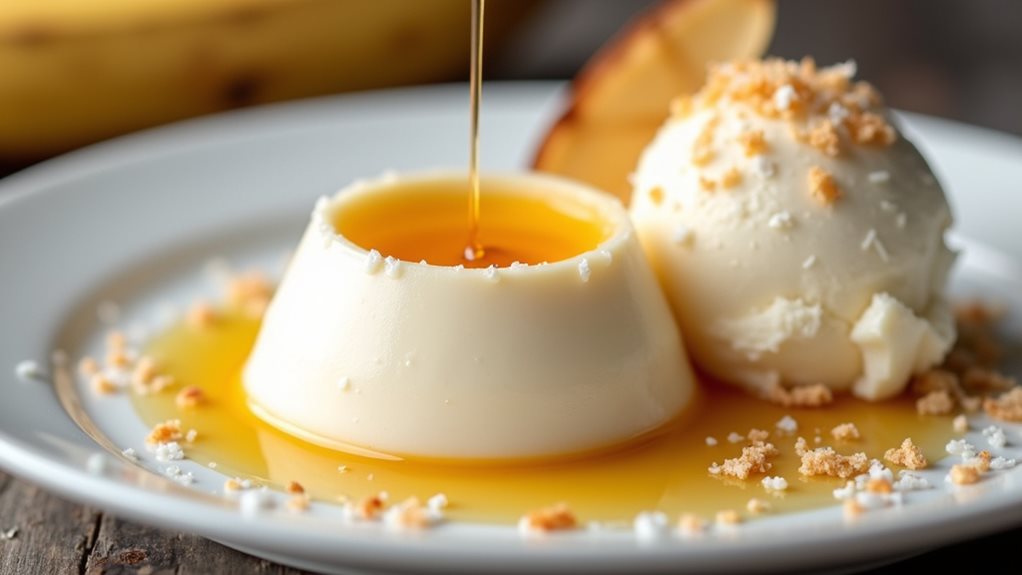Coconut pairs beautifully with tropical fruits like pineapple, mango, and passion fruit, while citrus options (lime, orange, lemon) provide bright contrast to its rich sweetness. For texture, add pecans, hazelnuts, or toasted seeds. Enhance your coconut dishes with warm spices like cinnamon and cardamom or fresh herbs such as cilantro and mint. Try coconut in both sweet applications (with chocolate) and savory dishes (with butternut squash or Thai curry ingredients). These combinations open doors to countless culinary possibilities.
The Classic Tropical Fruit Combinations

When exploring the world of coconut pairings, tropical fruits stand out as natural companions that elevate this versatile ingredient to new heights. The most celebrated tropical fruit combinations include pineapple, mango, passion fruit, kiwi, and lychee—each bringing unique qualities to coconut flavor profiles.
Pineapple's sweet-tart character balances coconut's creamy richness, creating iconic combinations like piña coladas. Mango adds a complementary tang while passion fruit introduces intense tropical notes that contrast beautifully with coconut's subtle sweetness. Papaya offers a buttery texture that works wonderfully with coconut in breakfast dishes and light desserts.
The harmonious marriage of tropical flavors dances on the palate when coconut meets its perfect fruit companions.
You'll find kiwi's slight acidity and unique texture create an exotic elegance, while lychee's floral notes offer sophisticated dimension to coconut dishes. Bananas bring a natural sweetness that pairs exceptionally well with coconut's creaminess in breads, smoothies, and pancakes.
Try caramelized pineapple with coconut flakes for a textural adventure, or blend mango and coconut for nutritious tropical smoothies.
Citrus Partnerships That Elevate Coconut Dishes
Though coconut's creamy richness stands impressively on its own, the bright, acidic notes of citrus fruits create magical flavor combinations that can transform ordinary dishes into extraordinary culinary experiences.
You'll find lime coconut pairings everywhere from tropical smoothies to sophisticated tarts, each offering that perfect balance of tang and sweetness.
Try adding orange zest to coconut cream for a luxurious twist in both desserts and savory sauces. The surprising bitterness of grapefruit sweetness cuts through coconut richness in salads and modern street food innovations. The Ultimate Fruit Flavor Pairing Chart serves as an excellent resource for inspiration when experimenting with these combinations.
For lighter applications, lemon brightness lifts coconut-based dishes without overwhelming them. Don't overlook cara cara sweetness, which provides a unique depth when combined with coconut in baked goods or creative empanadas that will impress even the most discerning palates.
According to mixology experts like Humberto Marques, coconut also pairs exceptionally well with tropical fruits in both cocktails and culinary applications.
Nuts and Seeds: Adding Texture and Depth

The strategic pairing of coconut with nuts and seeds creates a symphony of textures and flavors that elevate dishes to new culinary heights.
You'll find that pecans, with their buttery richness, complement coconut's tropical sweetness, while hazelnuts provide depth that transforms ordinary desserts into memorable experiences.
For innovative combinations, try incorporating the seed crunch of toasted sesame or pumpkin seeds into coconut-based curries or granolas. Middle Eastern dishes like dukkah feature coconut blended with sesame seeds and pistachios for texture, creating a versatile spice mix perfect for dipping.
These additions not only enhance the nutty textures but also boost nutritional value with healthy fats and fiber.
Marrying coconut with seeds and nuts creates textural masterpieces while delivering essential nutrients your body craves.
In Asian cuisines, you'll discover cashews melding seamlessly with coconut milk, while Middle Eastern traditions celebrate the marriage of coconut with pistachios in sweet confections. Cashews particularly enhance Asian flavors when paired with coconut in dishes featuring ginger, chili, and garlic.
Whether you're crafting energy balls or gourmet curries, the contrasting textures create multi-dimensional dishes that surprise and delight. Like regional barbecue techniques, temperature control matters when toasting nuts to bring out their optimal flavors alongside coconut.
Aromatic Herbs and Spices for Coconut Creations
Beyond texture, the world of coconut pairings extends into the vibrant domain of herbs and spices, where aromatic compounds create magical flavor combinations.
When exploring coconut flavor evolution, you'll discover that warm spices like cinnamon, cardamom, and cloves enhance the natural sweetness, while turmeric and ginger add depth to savory applications.
Fresh herbs offer another dimension to your coconut creations. Cilantro and mint bring brightness to coconut milk-based dishes, while lemongrass introduces a citrusy note that balances coconut milk benefits like creaminess and richness. Basil is another excellent addition that brings a distinctly Italian cuisine flair to coconut-based recipes. Malaysian cuisine demonstrates this principle beautifully with its rich coconut-herb combinations that create distinctive flavor profiles in traditional dishes.
For cultural authenticity, incorporate Thai influences with galangal and lemongrass, or explore Indian cuisine by combining turmeric, coriander seeds, and chilies with coconut milk. These aromatic additions transform simple coconut ingredients into complex, layered flavor experiences. Fermenting coconut with these spices can create umami taste while introducing beneficial probiotics that enhance both flavor and nutritional profiles.
Dairy and Creamy Complements to Coconut

When coconut meets dairy, a fascinating alchemy occurs that can transform both ingredients into something greater than their individual parts.
You'll find heavy cream and butter amplify coconut's natural richness while cream cheese adds tangy contrast in Coconut Dessert Frostings. For dairy-free options, coconut milk itself creates remarkably velvety textures in puddings and ice creams.
Try pairing coconut with complementary flavors like ginger for aromatic depth or vanilla for classic sweetness. Increasing ginger content in recipes can beautifully complement coconut's tropical profile.
Creamy Coconut Sauces benefit tremendously from these combinations—whether you're making a caramel sauce with coconut milk or a chocolate ganache using coconut cream. The extensive evaluation framework from Alpaca research provides insights into optimal flavor combinations for coconut-based recipes.
For something truly innovative, infuse your coconut cream with spices or fruit purées before whipping into fluffy toppings that elevate any dessert. Creating chocolate truffles with coconut cream instead of heavy cream offers a delightful tropical twist on the classic French confection.
Unexpected Vegetable Pairings for Savory Dishes
Coconut's tropical richness creates surprisingly harmonious combinations with roasted root vegetables, especially when you pair it with carrots, parsnips, and sweet potatoes for a warming, aromatic dish.
You can enhance butternut squash with coconut milk, cinnamon, and a touch of curry powder to bridge sweet and savory profiles in comfort food classics.
These unexpected vegetable pairings transform everyday ingredients into exotic creations, letting coconut's versatility shine in hearty, satisfying dishes beyond its traditional dessert applications.
For optimal results, cook your coconut-infused root vegetable medley at 400F (200C) to ensure perfect caramelization while preserving the natural sweetness of each component.
Roasted Root Vegetable Harmony
Although not immediately obvious, roasted root vegetables create a surprisingly harmonious pairing with coconut's tropical sweetness. When you combine the earthiness of carrots, parsnips, and sweet potatoes with coconut's creamy profile, you'll discover a compelling contrast that balances both flavors perfectly.
Try tossing your roasted vegetables in a light coconut oil before adding herbal infusions like rosemary and thyme. The natural caramelization that occurs during roasting enhances the root vegetables' inherent sweetness, creating a bridge to coconut's tropical notes.
For deeper complexity, incorporate cumin alongside garlic and onions to complement both the coconut and the earthiness of your vegetables. This unexpected pairing works beautifully in both winter comfort foods and lighter spring dishes, offering versatility that extends beyond typical coconut applications. For best results, roast at 425F (220C) for 25-35 minutes to achieve the perfect golden-brown exterior with tender interior that complements coconut's texture.
Spiced Squash Combinations
The humble squash transforms into an extraordinary vehicle for coconut's tropical essence, creating flavor combinations that you'd never expect to work so brilliantly.
Try butternut spiced with garam masala and coconut milk for a warming curry, or roast delicata with smoked paprika and coconut oil for a caramelized sweetness with a subtle heat.
Creamy kabocha pairs beautifully with coconut cream, earthy cumin, and a cayenne kick, while acorn sweetness is amplified when glazed with coconut sugar and maple sweetness.
Don't overlook spaghetti squash—toss it with coconut milk, herbaceous basil, and umami garlic for a dairy-free "pasta" dish.
For textural contrast, finish your coconut-squash creations with toasted seeds like nutty pepitas or scatter caramelized onions on top for depth that complements coconut's subtle sweetness.
For a velvety autumn soup, simmer butternut squash in vegetable broth before adding coconut milk as a heavy cream substitute that creates the perfect dairy-free comfort food.
Sweet and Savory Asian-Inspired Combinations
Coconut's creamy sweetness creates magic when balanced with the complex spices of curry, letting you experiment with heat levels while maintaining depth in dishes from Thailand to India.
When working with Thai flavor profiles, you'll find coconut pairs perfectly with lemongrass, kaffir lime, and galangal, creating the signature aromatic foundation that makes dishes like Tom Kha Gai so distinctive.
For an exciting culinary adventure, try combining coconut with gochujang or other spicy elements to create fusion dishes that bridge sweet and savory territories across Asian culinary traditions.
Consider fermenting vegetables like cabbage or carrots with coconut milk to develop a unique tangy flavor that complements the natural sweetness while providing beneficial bacteria for gut health.
Coconut-Curry Balance Magic
Discovering the perfect balance between coconut milk's creamy richness and curry's bold spices creates a culinary harmony that's central to many Asian cuisines.
When working with coconut flavor profiles, you'll find that turmeric, lemongrass, and galangal create a foundation that supports the milk's natural sweetness without overwhelming it.
Experiment with curry texture variations by adjusting your coconut milk type—full-fat delivers luxurious creaminess while light versions offer subtle background notes.
Brighten your creation with acidic elements like lime juice or kaffir lime leaves, which cut through richness and enhance complexity.
For complete balance, incorporate sweet vegetables such as squash or sweet potatoes, and finish with fresh herbs like cilantro or Thai basil.
Serve alongside coconut rice or naan bread to absorb every drop of your perfectly balanced sauce.
Use the natural release technique when finishing your coconut curry dishes to allow the flavors to fully meld and enhance the depth of your sauce.
Thai Flavor Profiles
Beyond curry applications, Thai cuisine offers a masterful blueprint for coconut pairings that elevate both sweet and savory dishes to memorable heights. The secret lies in Thai flavor balance—the harmonious interplay of salty fish sauce, palm sugar sweetness, chili heat, and aromatic herbs.
For savory creations, pair coconut milk with galangal, lemongrass, and kaffir lime leaves—aromatic ingredient combinations that create depth without heaviness.
Try infusing coconut rice with pandan leaf or complement coconut-based soups with mushrooms for umami richness.
In sweeter applications, coconut naturally complements tropical fruits like mango and pineapple, while palm sugar enhances its natural sweetness without overwhelming it.
Incorporating fermented elements like pickled mangoes into coconut dishes adds a layer of complexity and provides digestive aids through beneficial enzymes and anti-inflammatory properties.
Spicy-Sweet Fusion
What makes Asian-inspired coconut pairings so irresistible? It's the perfect balance of contrasting elements—creamy coconut milk tames fiery spices while enhancing their complex flavors.
This spicy sweet fusion creates memorable dishes that dance between comfort and excitement.
- Combine coconut milk with gochugaru (Korean chili flakes) and brown sugar for a sauce that delivers both heat and sweetness—perfect for marinating chicken or tofu.
- Layer flavor contrasts by adding soy sauce and palm sugar to coconut-based curries, creating depth that makes each bite more complex than the last.
- Try coconut cream with fresh lemongrass, star anise, and a touch of honey for a sauce that's aromatic, spicy, and subtly sweet—ideal for seafood dishes.
Dessert Flavor Profiles: Beyond the Basics
When crafting exceptional coconut-based desserts, you'll need to understand that truly memorable flavor profiles rely on a careful balance of multiple taste elements.
Don't just default to sweetness—explore the interplay between sweet, sour, bitter, and umami. Your coconut innovations will shine when you contrast creamy coconut with acidic fruits like lime or pineapple.
Texture creates as much impact as flavor. Combine silky coconut cream with crunchy toasted coconut flakes for an engaging mouthfeel experience.
Modern flavor experimentation often pairs coconut with unexpected elements like sea salt or spices to enhance its natural sweetness.
Remember that 59% of consumers respond to visual presentation, so consider color contrasts when plating—perhaps bright tropical fruits against white coconut cream for maximum appeal.
Bananas and coconut create a perfect harmony by combining the smooth texture with distinctive tropical notes that can be further enhanced through steaming.
Beverage Blends: Smoothies, Cocktails, and More
Although coconut shines in culinary creations, it truly reaches its versatile peak in beverage applications where its distinctive flavor profile can take center stage or complement other ingredients.
The unparalleled versatility of coconut reveals itself most brilliantly when transformed into beverages that showcase its unique tropical essence.
From tropical smoothie variations to elegant cocktails with coconut garnishes, you'll discover endless possibilities for refreshment.
- Smoothie Foundations – Create nutrient-rich bases by combining coconut with avocado for creaminess, dates for natural sweetness, or banana for smooth texture.
- Cultural Inspirations – Explore global traditions with coconut lassi from India, horchata from Latin America, or Thai iced tea infused with coconut milk.
- Cocktail Creativity – Transform classics by adding coconut to mojitos, margaritas, or rum punches, finishing with toasted coconut garnishes for visual appeal and aroma.
Regional Coconut Pairings From Around the World
Caribbean cuisine offers a fascinating contrast with its coconut curries, where the rich creaminess balances perfectly against fiery spices and bright citrus notes.
You'll find a similar balance in many Asian traditions, where coconut creates a delicate sweet-savory equilibrium in dishes ranging from Thai curries to Indian chutneys.
These regional approaches showcase coconut's remarkable versatility, adapting to both the bold heat of Caribbean cooking and the nuanced complexity of Asian flavor profiles.
Caribbean Curry Contrasts
Throughout the sun-drenched islands of the Caribbean, coconut serves as the cornerstone for some of the region's most distinctive curry creations.
You'll find the rich creaminess of coconut milk balancing the fiery spices in Jamaican curries, creating a harmonious blend that's both comforting and exciting. The versatility of coconut extends beyond curries into popular pairings that will transform your culinary repertoire.
- Try marinating jerk chicken in coconut milk before grilling for a perfect balance of heat and tropical sweetness.
- Enhance coconut shrimp by deglazing the pan with coconut whiskey, intensifying the natural flavors.
- Complete your Caribbean feast with tropical cocktails like piña coladas or Malibu Bay Breeze, where coconut rum provides the signature island flair.
Asian Sweet-Savory Balance
Moving from the bold flavors of the Caribbean, Asia offers its own remarkable coconut pairings that brilliantly balance sweet and savory elements. In Southeast Asia, you'll find coconut harmonizing with lemongrass, galangal, and chilis, while Indian cuisine blends it with aromatic cumin, coriander, and cardamom.
The cultural significance of coconut extends beyond flavor—it's essential in ceremonies and daily life throughout the region.
When experimenting with Asian coconut pairings, try Thai combinations of coconut milk with fish sauce and lime, or Sri Lankan blends featuring cinnamon and curry leaves.
The versatility of coconut showcases its adaptability across culinary traditions. This coconut sustainability is evident in how Asian cultures utilize every part of the tree, from milk and meat to shells and leaves, creating economically valuable and environmentally friendly food systems.
Frequently Asked Questions
Can Coconut Be Paired With Meats Like Chicken or Fish?
You'll find coconut chicken and coconut fish dishes are versatile culinary adventures. They're popular in Thai, Caribbean, and Southeast Asian cuisines, offering creamy texture, moisture retention, and complex flavor profiles for your innovative cooking.
How Does Coconut Interact With Chocolate in Dessert Recipes?
Like two dancers in perfect harmony, coconut and chocolate create a textural masterpiece in desserts. You'll find their contrasting textures delightful while the coconut chocolate balance elevates richness with tropical sweetness in innovative creations.
Are There Any Flavor Pairings to Avoid With Coconut?
When avoiding coconut pairings, beware of coconut flavor clashes with overly acidic ingredients. You'll want to avoid high-heat cooking methods and overwhelming delicate flavors. Instead, balance coconut's richness with complementary ingredients like tropical fruits.
What Wine Varietals Complement Coconut-Based Dishes Best?
For your coconut wine adventures, you'll find Gewürztraminer and off-dry Riesling create magical tropical pairings. Don't overlook Chardonnay's creamy notes or adventurous Condrieu options. Crisp rosés also cut through richness beautifully.
How Does Toasting Affect Coconut's Pairing Capabilities?
Toasting transforms coconut's pairing potential dramatically. You'll find toasted coconut flavors pair with more complex ingredients than raw coconut. Various toasting methods create different intensity levels, expanding your creative culinary possibilities beyond traditional combinations.
Final Thoughts
You've now explored coconut's remarkable versatility across culinary traditions worldwide. With over 50 scientifically documented flavor pairings, coconut offers more compatible combinations than almost any other tropical ingredient. Whether you're creating desserts, savory dishes, or innovative beverages, don't hesitate to experiment beyond conventional pairings. Your culinary adventures with coconut will continue to evolve as you discover personalized combinations that delight your particular palate.















